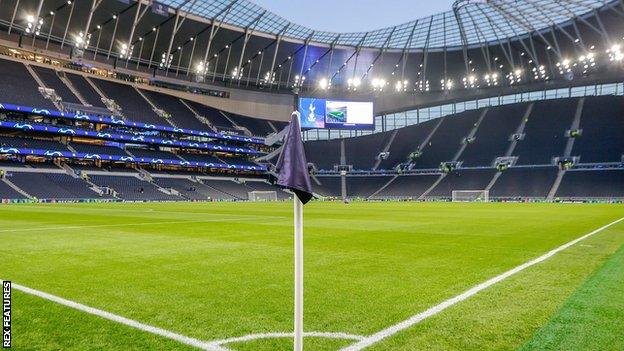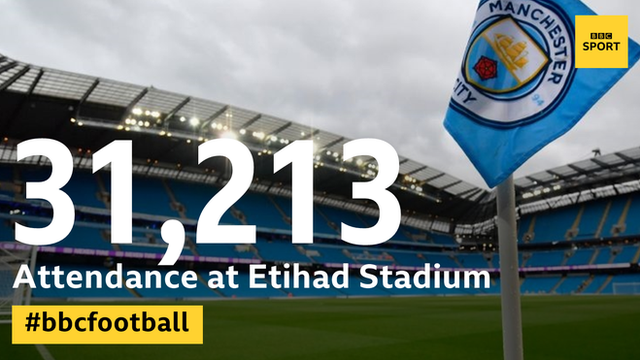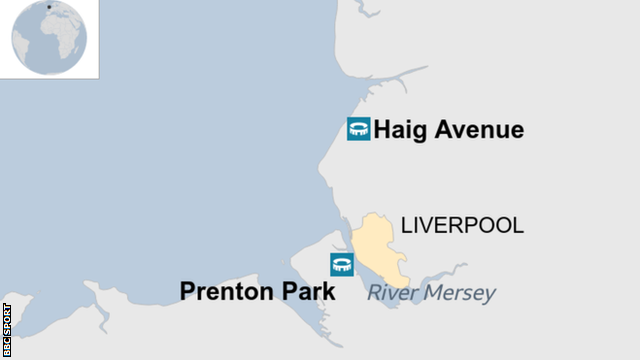Women's Super League: How much have big stadiums helped clubs?
- Published

The Tottenham Hotspur Stadium is one of four men's team grounds that will host WSL action this Sunday
Average attendances in the Women's Super League are more than four times higher than last season so far, having seen a major boost following this summer's World Cup in France.
Crowds across England's top flight have averaged 4,112 - boosted by a new WSL record of 31,213 when Manchester City hosted rivals Manchester United at Etihad Stadium in September - up from under 1,000 last term.
However, BBC Sport figures show that, even when excluding matches that have been held at clubs' men's home grounds with additional marketing, this season's WSL crowds are 47% higher than the last campaign.
Further matches will be played at big venues on Sunday, 17 November, during the Football Association's inaugural Women's Football Weekend, with a north London derby at the Tottenham Hotspur Stadium, a Merseyside derby at Anfield and games at Reading's Madejski Stadium and Brighton's Amex Stadium.
Those fixtures are set to help bring a further surge in attendances. But how much can the recent rises be attributed to fixtures being held at larger stadiums, and how much is down to the wider growth in the sport's appeal?
More match-going fans than ever before

Manchester City's derby victory over rivals Manchester United was watched by a league-record crowd
With just five rounds of the 22-match season completed, this campaign's cumulative attendance has already surpassed 2018-19's overall total.
The turnstiles were spun 119,248 times across the league during September and October, which is more than the 106,960 from all of last term, although the division has gained an additional team.
Individually, of last season's WSL clubs who are yet to play a home league game away from their normal venue this term, Arsenal, Liverpool, Brighton, Birmingham City and Everton have all seen notable rises in their gates.
Last summer's promotion to the WSL of two comparatively well-supported sides, in Manchester United and Tottenham Hotspur, has also been a factor in the overall growth.
United, managed by former England defender Casey Stoney, attracted the highest average home attendance in the country last season, despite being in the second tier, so their arrival in the WSL was naturally expected to boost the competition's overall crowd figures.
Their home league gates of 2,530, 2,813 and 1,997 so far this term are all well above the league's norms in their own right, while Tottenham have also averaged more than 1,000 from their first two home league games.
Reading have seen a slight drop in the early stages of this campaign, but they have only played twice at home so far and will return to the Madejski on Sunday when they host Bristol City.
Are 'big events' followed by boosts in the next home game?
One of the key challenges facing WSL clubs is attempting to encourage fans who attend a one-off 'big event' match - perhaps seeing their first live women's game - to then return for future home games that are staged at the team's normal, smaller venue.
But this season's examples indicate that clubs are indeed managing to do just that.
After 24,564 saw Chelsea's season opener at Stamford Bridge, their second home game - back at their normal Kingsmeadow base - drew in a lively 4,149 crowd for their win over Arsenal. That was more than double the Blues' average home gate for 2018-19.
Similarly, Bristol City, Manchester City and West Ham's home games that followed their matches at Ashton Gate, the Etihad and the London Stadium respectively all attracted crowds that exceeded their typical 2018-19 home attendance.
But the picture isn't entirely rosy everywhere in the country.
WSL 2018-19 season average crowds - BBC Sport figures | |
|---|---|
Chelsea - 2,040 | Reading - 844 |
Arsenal - 1,586 | Yeovil - 719 |
Manchester City - 1,505 | Liverpool - 536 |
Brighton - 975 | Bristol City - 528 |
West Ham - 880 | Everton - 217 |
Birmingham City - 886 | |
Are locations adding to the challenge for some teams?
Everton's average home league crowd for last season was, according to BBC figures, the lowest in the division by a considerable margin.
The club have seen a 77% rise so far this season and will be boosted by their upcoming move to Merseyside and their new home of Walton Hall Park.
The Toffees have been playing 16.3 miles from Goodison Park at Southport's Merseyrail Community Stadium since last term, with the distance arguably being a major factor in the club's lower turnouts in 2018-19.
Yet Everton have not being playing the furthest from their male counterparts' home.

Liverpool Women's home ground Prenton Park, in Birkenhead, is 6.1 miles and across the River Mersey from the city's Anfield stadium where the men's team play. The distance between Everton Women's Haig Avenue and the men's Goodison Park is 16.3 miles
Travelling the greatest distance are Reading, whose long-term base is Adams Park - home of League One men's side Wycombe Wanderers - some 26.4 miles away from the Madejski Stadium.
But that did not stop them attracting an average home league crowd nearly four times that of Everton's in the 2018-19 campaign.
Arsenal, Brighton, Manchester United, Spurs and West Ham all also play more than 10 miles away from their men's team.
But with more matches expected to be held at men's Premier League venues later in the season, records could continue to tumble in this term's WSL.
BBC Sport has launched #ChangeTheGame to showcase female athletes in a way they never have been before. Through more live women's sport available to watch across the BBC in 2019, complemented by our journalism, we are aiming to turn up the volume on women's sport and alter perceptions. Find out more here.